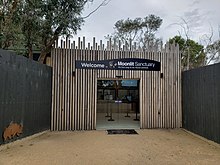Moonlit Sanctuary Wildlife Conservation Park
Moonlit Sanctuary Wildlife Conservation Park is a 25-acre (10 ha) biopark within the Pearcedale Conservation Park located at Pearcedale on the Mornington Peninsula near Melbourne, Australia. It aims to display the fauna that was found in the Mornington Peninsula and Western Port Biosphere Reserve prior to European settlement as well as working towards the recovery of threatened Australian fauna. The park is open all year except on Christmas Day. The sanctuary, as part of Pearcedale Conservation Park, is an institutional member of the Zoo and Aquarium Association (ZAA). It is ECO Certified at the Ecotourism level by Ecotourism Australia.[4]
 | |
| Date opened | 2001 |
|---|---|
| Location | Pearcedale, Victoria, Australia |
| Coordinates | 38.2128697°S 145.2497506°E |
| Land area | 25 acres (10 ha) |
| No. of animals | 400[1] |
| No. of species | 60[1] |
| Memberships | ZAA,[2] Ecotourism Australia[3] |
| Website | www |
History

Development of the zoo started in December 1998, with construction of a visitor center, a 2-acre (0.81 ha) wetland habitat with a lake, and more than 30 animal enclosures, as well as many Australian trees and other plants. The zoo was opened in September 2001.[1]
Evening walks
Moonlit Sanctuary operates evening walks, which are an environmental immersion experience. A guide takes visitors on a walk through natural bushland where the guide spotlights a variety of nocturnal animals, many of them endangered. The guide gives talks about the animals, and answers visitors’ questions. Visitors come into close contact with the animals in their natural habitats and can observe their natural behaviours. This is different visitor experience from a normal zoo visit where visitors view a large number of species for short periods of time and rarely bother reading signs. Moonlit Sanctuary visitors spend longer periods of time with a small number of animals, and receive a lot of information from the accompanying guide.
Daytime visits
Moonlit Sanctuary is also open during the day, where visitors get an experience closer to a normal zoo. It operates education services for school children, and provides research facilities for graduate students. It also engages in conservation breeding of endangered species.
Animals
Animals kept at the Sanctuary include spot-tailed quolls, southern bettongs, squirrel gliders, long-nosed potoroo, red-bellied pademelon, spinifex hopping mouse, fat-tailed dunnart, brush-tailed bettong, red-necked wallaby, feathertail glider, sugar glider, Tasmanian masked owl, tawny frogmouth, Cape Barren goose, bush thicknee, Victorian carpet python, blue-tongue lizard, and Gippsland water-dragon. In total over 400 animals representing over 60 different species call the sanctuary home.[5]
Conservation
Moonlit has successfully bred a number of rare and endangered species including southern bettong (aka eastern bettong), eastern quoll, Julia Creek dunnart, fluffy glider (yellow-bellied glider) and squirrel glider. The eastern quoll and southern bettong are now extinct on the mainland and only found in the wild in Tasmania. In 2016 it opened a new breeding facility for the critically endangered orange-bellied parrots, designed to house up to 20 pairs.
Awards
In 2009 Moonlit Sanctuary won the Victorian Keep Australia Beautiful award for Preservation of the Environment with an emphasis on local fauna and flora.[6]
In 2010 Moonlit Sanctuary won the Victorian Tourism Award for Ecotourism.,[7] won this award for a second time in 2014.[8] and for a third time in 2018.[9]
In 2017 Moonlit Sanctuary won the Premier’s Sustainability Award for Environmental Protection for their Orange-bellied Parrot Breeding for Recovery program.
In 2018 Moonlit Sanctuary won the Victorian Tourism Award for Tourism Attraction as well as Ecotourism.[9] Subsequently they won Silver for Ecotourism at the 2018 Australian Tourism Awards.[10]
Notes
- "About Us". moonlit-sanctuary.com. Moonlit Sanctuary. Retrieved 26 November 2010.
- "Zoo and Aquarium Association Institutional Members' Directory". zooaquarium.org.au. Zoo and Aquarium Association. Archived from the original on 31 October 2010. Retrieved 5 September 2010.
- "Search for Green Travel Experiences (Business type=Attraction, Keywords=moonlit)". ecotourism.org.au. Ecotourism Australia. Retrieved 1 December 2010.
-
"Eco Certification Program". ecotourism.org.au. Ecotourism Australia. Retrieved 1 December 2010.
Ecotourism: Tourism in a natural area that offers interesting ways to learn about the environment with an operator that uses resources wisely, contributes to the conservation of the environment and helps local communities.
- "Moonlit Sanctuary Wildlife Conservation Park, Mornington Peninsula". ozanimals.com. OzAnimals Travel. Retrieved 26 November 2010.
- Johnson, Michael (31 May 2009). "News: Moonlit Sanctuary wins Protection of Environment award!". moonlit-sanctuary.com. Moonlit Sanctuary. Retrieved 1 December 2010.
- "2010 Victorian Tourism Awards". victoriantourismawards.com.au. Victorian Tourism Awards. Retrieved 1 December 2010.
- http://www.victoriantourismawards.com.au/entrants-and-results/2014-awards-winners/2014-awards-winners.html
- http://www.victoriantourismawards.com.au/winners-and-finalists//
- https://qualitytourismaustralia.com/australian-tourism-awards/2018-award-winners/